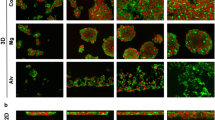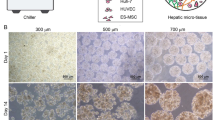Abstract
Cancer cell lines of human tissue origin have been extensively used to investigate antiproliferative activity and toxicity of herbal extracts, isolated compounds, and anticancer drugs. These cell lines are genetically and/or epigenetically well characterized to determine the altered expression of proteins within given cellular pathways and critical genes in cancer. Human derived hepatoma (HepG2) cell line has been extensively exploited to examine cytoprotective, antioxidative, hepatoprotective, anti-hepatoma, hypocholesterolemic, anti-steatosis, bioenergetic homeostatic and anti-insulin resistant properties. Moreover, mechanism of action of various botanicals and bioactive constituents has been reported using these cells. HepG2 cells have significant differences as compared to primary hepatocytes with respect to expression of cytochrome P450 enzymes and xenobiotic receptors in conventional in vitro culture conditions. Therefore, strategies have been employed to overcome limitations of two dimensional (2D) in vitro HepG2 cell culture in order to recognize functional biomarkers more accurately and to boost its predictive value in clinical research. In consequence, three dimensional (3D) human hepatoma cell culture models are being developed as a resource to achieve these goals of simulating the in vivo tumor microenvironment. It is assumed that bioengineered 3D hepatoma cell culture models can provide significant assistance in scrutinizing the molecular response of herbal natural products to recognize novel prognostic targets and crucial biomarkers in treatment strategies for cancer patients in near future.


Similar content being viewed by others
References
ATCC. https://www.atcc.org/products/all/HB-8065.aspx#characteristics. Accessed 24 Nov 2017
Alia M, Ramos S, Mateos R, Granado-Serrano AB, Bravo L, Goya L (2006) Quercetin protects human hepatoma HepG2 against oxidative stress induced by tert-butyl hydroperoxide. Toxicol Appl Pharmacol 212:110–118
Aritomi K, Ishitsuka Y, Tomishima Y, Shimizu D, Abe N, Shuto T, Irikura M, Kai H, Irie T (2014) Evaluation of three-dimensional cultured HepG2 cells in a nano culture plate system: an in vitro human model of acetaminophen hepatotoxicity. J Pharmacol Sci 124:218–229
Bhatia D, Mandal A, Nevo E, Bishayee A (2015) Apoptosis-inducing effects of extracts from desert plants in HepG2 human hepatocarcinoma cells. Asian Pac J Trop Biomed 5:87–92
Bhise NS, Manoharan V, Massa S, Tamayol A, Ghaderi M, Miscuglio M, Lang Q, Shrike Zhang Y, Shin SR, Calzone G, Annabi N, Shupe TD, Bishop CE, Atala A, Dokmeci MR, Khademhosseini A (2016) A liver-on-a-chip platform with bioprinted hepatic spheroids. Biofabrication 8:014101. https://doi.org/10.1088/1758-5090/8/1/014101
Bokhari M, Carnachan RJ, Cameron NR, Przyborski SA (2007) Culture of HepG2 liver cells on three dimensional polystyrene scaffolds enhances cell structure and function during toxicological challenge. J Anat 211:567–576
Cao Z, Lin W, Huang Z, Chen X, Zhao J, Zheng L, Ye H, Liu Z, Liao L, Du J (2013) Ethyl acetate extraction from a Chinese herbal formula, Jiedu Xiaozheng Yin, inhibits the proliferation of hepatocellular carcinoma cells via induction of G0/G1 phase arrest in vivo and in vitro. Int J Oncol 42:202–210
Chen ML, Ip SP, Tsai SH, Ko KM, Che CT (2010) Biochemical mechanism of Wu-Zi-Yan-Zong-Wan, a traditional Chinese herbal formula, against alcohol-induced oxidative damage in CYP2E1 cDNA-transfected HepG2 (E47) cells. J Ethnopharmacol 128:116–122
Chu Q, Zhao Y, Shi X, Han W, Zhang Y, Zheng X, Zhu J (2017) In vivo-like 3-D model for sodium nitrite- and acrylamide-induced hepatotoxicity tests utilizing HepG2 cells entrapped in micro-hollow fibres. Sci Rep 7:14837. https://doi.org/10.1038/s41598-017-13147-z
Derda R, Laromaine A, Mammoto A, Tang SK, Mammoto T, Ingber DE, Whitesides GM (2009) Paper-supported 3D cell culture for tissue-based bioassays. Proc Natl Acad Sci USA 106:18457–18462
Duval K, Grover H, Han L, Mou Y, Pegoraro AF, Fredberg J, Chen Z (2017) Modeling physiological events in 2D vs. 3D cell culture. Physiology 32:266–277
Edmondson R, Broglie JJ, Adcock AF, Yang L (2014) Three-dimensional cell culture systems and their applications in drug discovery and cell-based biosensors. Assay Drug Dev Technol 12:207–218
Farshori NN, Al-Sheddi ES, Al-Oqail MM, Hassan WH, Al-Khedhairy AA, Musarrat J, Siddiqui MA (2015) Hepatoprotective potential of Lavandula coronopifolia extracts against ethanol induced oxidative stress-mediated cytotoxicity in HepG2 cells. Toxicol Ind Health 31:727–737
Feng Q, Gou XJ, Meng SX, Huang C, Zhang YQ, Tang YJ, Wang WJ, Xu L, Peng JH, Hu YY (2013) Qushi Huayu decoction inhibits hepatic lipid accumulation by activating AMP-activated protein kinase in vivo and in vitro. Evid Based Complement Altern Med 2013:184358. https://doi.org/10.1155/2013/184358
Ferreira D, Adega F, Chaves R (2013) The importance of cancer cell lines as in vitro models in cancer methylome analysis and anticancer drugs testing. In: César LC, Elena AO (eds) Oncogenomics and cancer proteomics—novel approaches in biomarkers discovery and therapeutic targets in cancer. InTech Publishers, Rijeka, pp 139–166
Han W, Hou G, Liu L (2015) Polyphyllin I (PPI) increased the sensitivity of hepatocellular carcinoma HepG2 cells to chemotherapy. Int J Clin Exp Med 8:20664–20669
Iizuka A, Yoshie F, Amagaya S, Yasuda T, Iizuka M, Yamaguchi H, Nagumo S, Kondo K (2013) Effect of Dai-Saiko-To (Da-Chai-Hu-Tang) on LDL-Receptor gene expression in human hepatoma cell line (HepG2). Am J Plant Sci 4:454–459
Jeon H, Kang K, Park SA, Kim WD, Paik SS, Lee SH, Jeong J, Choi D (2017) Generation of multilayered 3D structures of HepG2 cells using a bio-printing technique. Gut Liver 11:121–128
Kong KW, Mat-Junit S, Aminudin N, Hassan FA, Ismail A, Aziz AA (2016) Protective effects of the extracts of Barringtonia racemosa shoots against oxidative damage in HepG2 cells. PeerJ 4:e1628. https://doi.org/10.7717/peerj.1628
Lan SF, Starly B (2011) Alginate based 3D hydrogels as an in vitro co-culture model platform for the toxicity screening of new chemical entities. Toxicol Appl Pharmacol 256:62–72
Liang H, Zhang L, Wang H, Tang J, Yang J, Wu C, Chen S (2015) Inhibitory effect of Gardenoside on free fatty acid-induced steatosis in HepG2 hepatocytes. Int J Mol Sci 16:27749–27756
Luckert C, Schulz C, Lehmann N, Thomas M, Hofmann U, Hammad S, Hengstler JG, Braeuning A, Lampen A, Hessel S (2017) Comparative analysis of 3D culture methods on human HepG2 cells. Arch Toxicol 91:393–406
Ma JZ, Yang LX, Shen XL, Qin JH, Deng LL, Ahmed S, Xu HX, Xue DY, Ye JX, Xu G (2014) Effects of traditional Chinese medicinal plants on anti-insulin resistance bioactivity of DXMS-induced insulin resistant HepG2 cells. Nat Prod Bioprospect 4:197–206
Nakamura K, Mizutani R, Sanbe A, Enosawa S, Kasahara M, Nakagawa A, Ejiri Y, Murayama N, Miyamoto Y, Torii T, Kusakawa S, Yamauchi J, Fukuda M, Yamazaki H, Tanoue A (2011) Evaluation of drug toxicity with hepatocytes cultured in a micro-space cell culture system. J Biosci Bioeng 111:78–84
Niu N, Wang L (2015) In vitro human cell line models to predict clinical response to anticancer drugs. Pharmacogenomics 16:273–285
Ramachandran S, Menon DB (2016) Synergistic effect of spices in a decoction regulates the energy metabolism in liver cancer cells. Int J Phytomed 8:29–36
Ramaiahgari SC, Den Braver MW, Herpers B, Terpstra V, Commandeur JN, van de Water B, Price LS (2014) A 3D in vitro model of differentiated HepG2 cell spheroids with improved liver-like properties for repeated dose high-throughput toxicity studies. Arch Toxicol 88:1083–1095
Ravi M, Paramesh V, Kaviya SR, Anuradha E, Solomon FD (2015) 3D cell culture systems: advantages and applications. J Cell Physiol 230:16–26
Samarakoon SR, Thabrew I, Galhena PB, Tennekoon KH (2012) Modulation of apoptosis in human hepatocellular carcinoma (HepG2 cells) by a standardized herbal decoction of Nigella sativa seeds, Hemidesmus indicus roots and Smilax glabra rhizomes with anti-hepatocarcinogenic effects. BMC Complement Altern Med 12:25. https://doi.org/10.1186/1472-6882-12-25
Sarika PR, James NR, Anilkumar PR, Raj DK, Kumary TV (2016) Microgravity as a means to incorporate HepG2 aggregates in polysaccharide–protein hybrid scaffold. J Mater Sci Mater Med 27:27. https://doi.org/10.1007/s10856-015-5638-5
Shen T, Li X, Hu W, Zhang L, Xu X, Wu H, Ji L (2015) Hepatoprotective effect of phenylethanoid glycosides from Incarvillea compacta against CCl4-induced cytotoxicity in HepG2 cells. J Korean Soc Appl Biol Chem 58:617–625
Shivananjappa MM, Mhasavade D, Joshi MK (2013) Aqueous extract of Terminalia arjuna attenuates tert-butyl hydroperoxide-induced oxidative stress in HepG2 cell model. Cell Biochem Funct 31:129–135
Vernetti LA, Vogt A, Gough A, Taylor DL (2017) Evolution of experimental models of the liver to predict human drug hepatotoxicity and efficacy. Clin Liver Dis 21:197–214
Wang N, Feng Y, Tana HY, Cheung F, Hong M, Lao L, Nagamatsu T (2015) Inhibition of eukaryotic elongation factor-2 confers to tumor suppression by a herbal formulation Huanglian-Jiedu decoction in human hepatocellular carcinoma. J Ethnopharmacol 164:309–318
Yip D, Cho CH (2013) A multicellular 3D heterospheroid model of liver tumor and stromal cells in collagen gel for anti-cancer drug testing. Biochem Biophys Res Commun 433:327–332
Yotsumoto H, Yanagita T, Yamamoto K, Ogawa Y, Cha JY, Mori Y (1997) Inhibitory effects of Oren-Gedoku-to and its components on cholesteryl ester synthesis in cultured human hepatocyte HepG2 cells: evidence from the cultured Hep2G cells and in vitro assay of ACAT. Planta Med 63:141–145
Zheng YS, Zhang JY, Zhang DH (2015) Fatsioside A-induced apoptotic death of HepG2 cells requires activation of AMP-activated protein kinase. Mol Med Rep 12:5679–5684
Zuchowska A, Kwapiszewska K, Chudy M, Dybko A, Brzozka Z (2017) Studies of anticancer drug cytotoxicity based on long-term HepG2 spheroid culture in a microfluidic system. Electrophoresis 38:1206–1216
Acknowledgements
The first author duly acknowledges the University Grants Commission (UGC), New Delhi for providing Scholarship under the Scheme MANF (vide Grant No. 201213-MANF-2012-13-SIK-PUN-16650).
Author information
Authors and Affiliations
Corresponding author
Rights and permissions
About this article
Cite this article
Kaur, P., Robin, Mehta, R.G. et al. Progression of conventional hepatic cell culture models to bioengineered HepG2 cells for evaluation of herbal bioactivities. Biotechnol Lett 40, 881–893 (2018). https://doi.org/10.1007/s10529-018-2547-y
Received:
Accepted:
Published:
Issue Date:
DOI: https://doi.org/10.1007/s10529-018-2547-y




